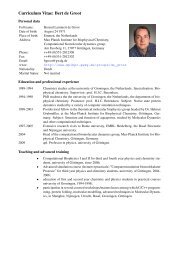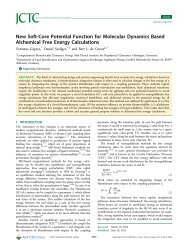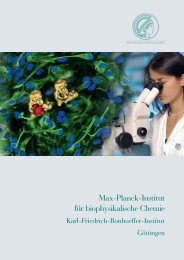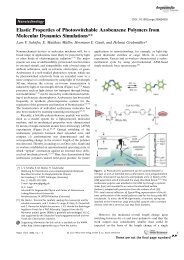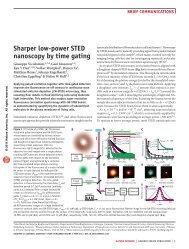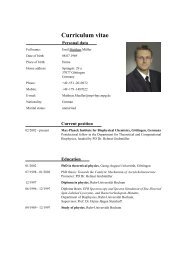Seminar for PhD students - Max-Planck-Institut für biophysikalische ...
Seminar for PhD students - Max-Planck-Institut für biophysikalische ...
Seminar for PhD students - Max-Planck-Institut für biophysikalische ...
Sie wollen auch ein ePaper? Erhöhen Sie die Reichweite Ihrer Titel.
YUMPU macht aus Druck-PDFs automatisch weboptimierte ePaper, die Google liebt.
Jörg Mittelstät<br />
Physical Biochemistry<br />
Organizing team: W. Fischle, G. Groenhof, C. Höbartner, S. Jakobs, A. Lange<br />
Induced fit in biological recognition: GTPase activation of<br />
translation elongation factor Tu on the ribosome<br />
The ribosome synthesizes proteins from<br />
aminoacyl-tRNAs (aa-tRNAs) based on the<br />
sequence of codons of an mRNA template.<br />
During decoding, aa-tRNA is delivered to<br />
the ribosome in a very tight complex with<br />
elongation factor Tu (EF-Tu) and GTP. The<br />
release of aa-tRNA from EF-Tu requires<br />
GTP hydrolysis which, in turn, is allowed<br />
only when codon recognition has taken<br />
place. The mechanism of coupling is induced<br />
fit. After initial binding, the anticodon<br />
of the aa-tRNA in the complex with<br />
EF-Tu probes the mRNA codon presented<br />
in the decoding site of the ribosome<br />
(Fig. 1). When the anticodon matches the<br />
codon, rapid GTP hydrolysis is triggered,<br />
which is an important checkpoint <strong>for</strong> tRNA<br />
selection. If the codon-anticodon duplex<br />
contains mismatches, activation of GTP<br />
hydrolysis is very slow which allows the<br />
ribosome to reject the incorrect substrate.<br />
How codon recognition is signaled from<br />
the decoding center to the GTP binding<br />
pocket of EF-Tu, which is located more<br />
than 75 Å away, is not understood. Transient<br />
distortions of the aa-tRNA were suggested<br />
to have an active role in signaling<br />
and in this study we tested this hypothesis.<br />
Transient con<strong>for</strong>mational changes<br />
of tRNA during binding of the EF-Tu<br />
GTP·aminoacyl-tRNA complex can be followed<br />
in a stopped-flow apparatus monitoring<br />
the fluorescence intensity changes<br />
of a proflavin label attached to aa-tRNA.<br />
When a codon complementary to the<br />
aa-tRNA is found in the A site, the tRNA assumes<br />
a short-lived con<strong>for</strong>mation of higher<br />
fluorescence (Fig. 1A), which is due to the<br />
distortion of the tRNA molecule. The higher<br />
sensitivity of the fluorophore against<br />
quenching by potassium iodide (Fig. 1A)<br />
indicates that the tRNA molecule in the<br />
transient state has a somewhat more open<br />
con<strong>for</strong>mation. A similar distortion is observed<br />
also upon aa-tRNA binding at a<br />
near-cognate codon (Fig. 1B and C), however,<br />
only <strong>for</strong> a very small fraction of the<br />
tRNA molecules, which correlates with<br />
Seite 23<br />
<strong>Seminar</strong><br />
<strong>Seminar</strong> <strong>for</strong><br />
<strong>for</strong> <strong>PhD</strong><br />
<strong>PhD</strong> <strong>students</strong><br />
<strong>students</strong><br />
21.10.2009<br />
17:00 c.t.<br />
Large seminar room<br />
the level of misreading at the initial selection<br />
step, i.e. be<strong>for</strong>e GTP is hydrolyzed.<br />
Our data favors a model in which tRNA<br />
distortion is required <strong>for</strong> the GTPase activation<br />
in EF-Tu, and is involved in communicating<br />
the signal from the decoding site<br />
to the factor. Aa-tRNA enters the decoding<br />
site and samples the mRNA codon in<br />
a non-distorted con<strong>for</strong>mation; <strong>for</strong>mation<br />
of the cognate codon-anticodon complex<br />
induces con<strong>for</strong>mational changes of the<br />
ribosome, aa-tRNA and EF-Tu resulting<br />
in the activation of GTP hydrolysis by<br />
EF-Tu – an example of how induced fit can<br />
be used <strong>for</strong> substrate selection.<br />
References <strong>for</strong> further reading:<br />
Rodnina, M.V. (2009a) Long-range signalling in<br />
activation of the translational GTPase EF-Tu.<br />
EMBO J 28: 619-620.<br />
Rodnina, M. V. (2009b) Visualizing the protein<br />
synthesis machinery: New focus on the translational<br />
GTPase elongation factor Tu. Proc Natl<br />
Acad Sci USA 106: 969-70.<br />
Schuette, J.-C., Murphy, F. V., Kelley, A. C., Weir,<br />
J. R., Giesebrecht, J., Connell, S. R., Loerke, J.,<br />
Mielke, T., Zhang, W., Penczek, P. A., Ramakrishnan<br />
V., and Spahn, C. M. T. (2009) GTPase<br />
activation of elongation factor EF-Tu by the ribosome<br />
during decoding. EMBO J 28: 755-765.<br />
Villa, E., Sengupta, J., Trabuco, L. G., LeBarron,<br />
J., Baxter, W. T., Shaikh, T. R., Grassucci, R.<br />
A., Nissen, P., Ehrenberg, M., Schulten, K. and<br />
Frank, J. (2009) Ribosome-induced changes<br />
in elongation factor Tu con<strong>for</strong>mation control<br />
GTP hydrolysis. Proc Natl Acad Sci USA 106:<br />
1063-1068.<br />
Fig. 1: A. Sequence of steps during GTPase activation of EF-Tu on the ribosome (modified from Rodnina et al., 2009a). E, P and A denote the three<br />
tRNA binding sites of the ribosome. GTP* denotes the GTPase-activated con<strong>for</strong>mation of EF-Tu. Distortion of the tRNA molecule is indicated by a kink.<br />
B-D. Distortion of the aa-tRNA during A-site binding monitored by transient fluorescence quenching. B) Cognate codon. C) Near-cognate codon with<br />
a single mismatch in the codon-anticodon duplex. The topmost trace (dark blue) is the unquenched signal while the lower traces (blue to light blue) are<br />
obtained by increasing the concentration of potassium iodide (KI) in the reaction. D) Analysis of the differential amplitudes of the high-fluorescence intermediates<br />
according to the Stern-Volmer equation in the following <strong>for</strong>m: A 0 - A = A0(1-1/(1+K SV[KI])), where A 0-A is the amplitude of the fluorescence<br />
increase determined from differential curves (not shown), yields quenching constants (K SV) of 11 ± 3 M -1 <strong>for</strong> the cognate and 22 ± 6 M -1 <strong>for</strong> the nearcognate<br />
codon. Compared to a quenching constant of 5 ± 0.1 M -1 determined <strong>for</strong> the free tRNA, this indicates a distorted, more open con<strong>for</strong>mation of<br />
the tRNA in both cases. However, only a small fraction of the tRNA molecules undergoes the distortion at a near-cognate codon.




